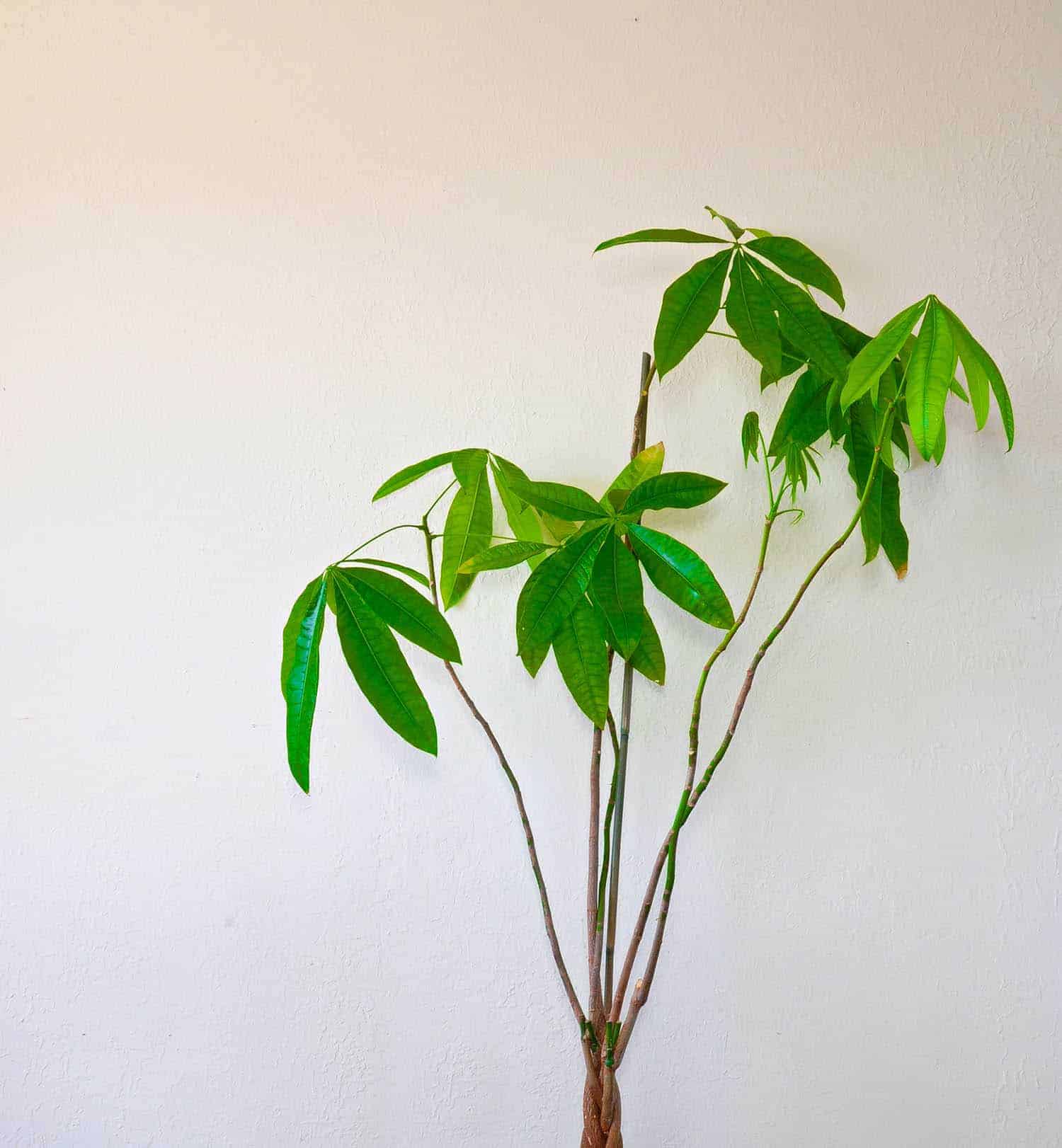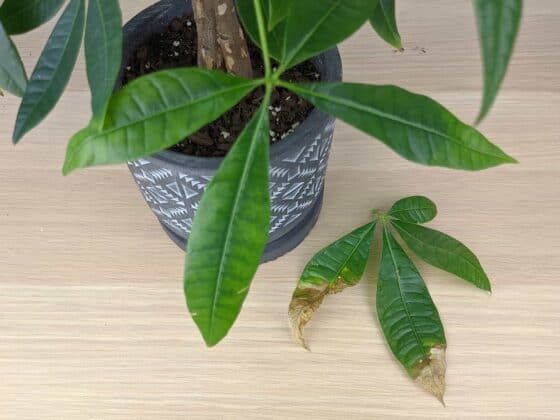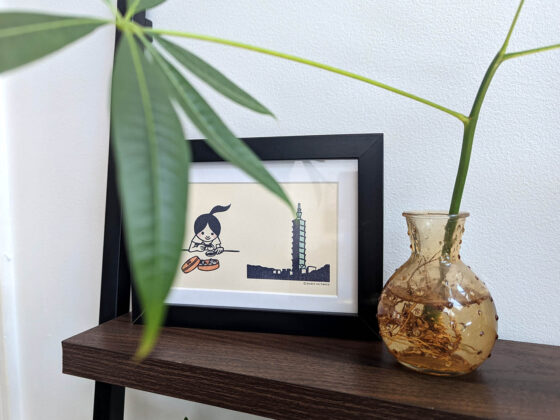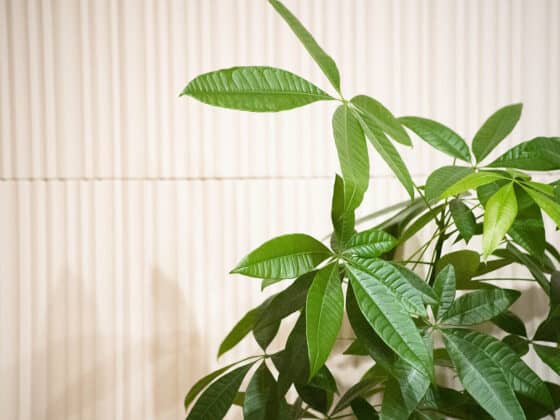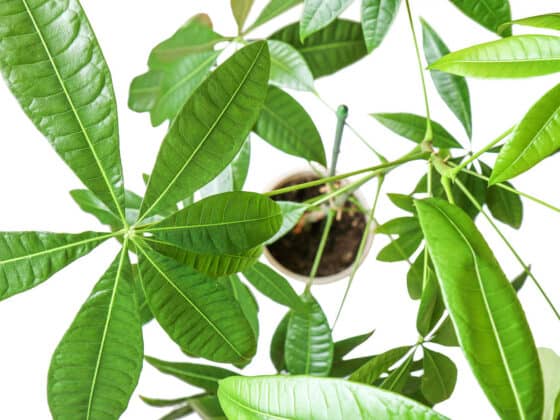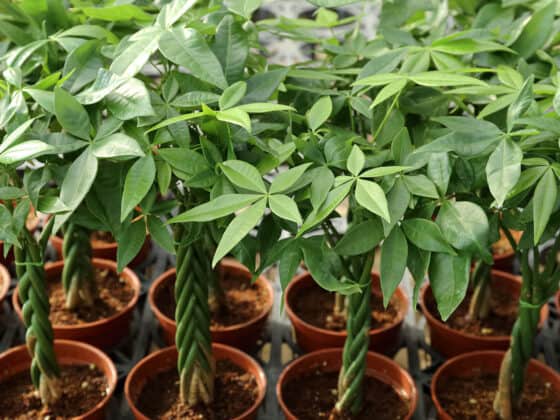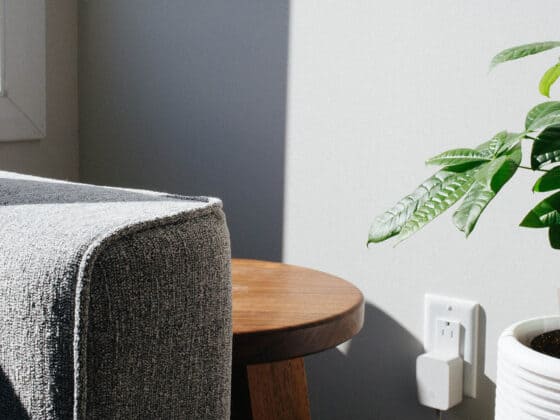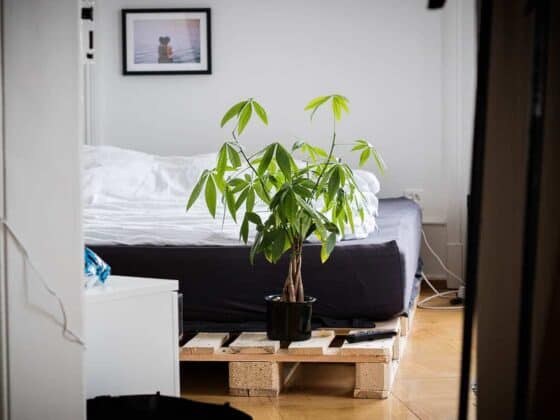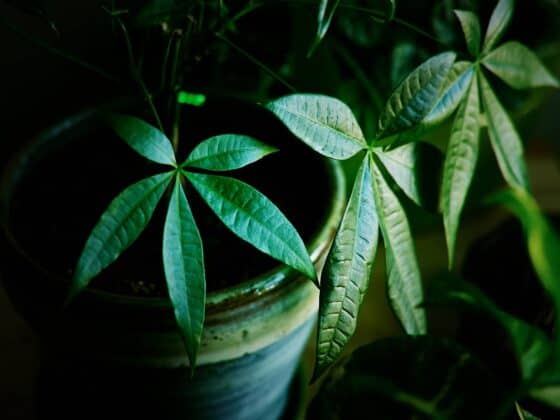If you have a Money Tree for any extended period of time and you’ve recently started to notice that it isn’t growing like it used to, your tree could be in need of some extra nutrients. Fertilizer can serve up much-needed nutrients and give your Money Tree that extra oomph it needs to start growing again.
For healthy, long-living Money Trees, you should fertilize once a month during the growing season with a mixture that has been diluted to half strength. Initially, Money Trees gather nutrients from their potting soil, but after 6-12 months, that source is depleted, and additional nutrients should be added via fertilizer.
If you are new to the fertilizer world, just a quick glance at the options is enough to make your head spin. Between N-P-K ratios and choices like organic vs. synthetic or liquid vs. granular, choosing the right fertilizer can seem overwhelming. Thankfully, these choices can be broken down simply, and with just a little bit of information, you’ll be on your way to a healthier, happier Money Tree.
Why Money Trees Need Fertilizer
Money Trees, as well as all other houseplants, need the following things to survive: water, sunlight, and carbon dioxide. The combination of those three things, along with the photosynthesis process, is what allows plants to turn energy into food for them. Fertilizer does not affect this process.
People often mistake fertilizer for food for the plant, but this isn’t correct. Plants make their own food. I like to think of fertilizer more like vitamins. A plant can survive with just water, sunlight, and CO2, but to thrive, they need Phosphorus, Potassium, Nitrogen, and several other minerals. Enter Fertilizer.
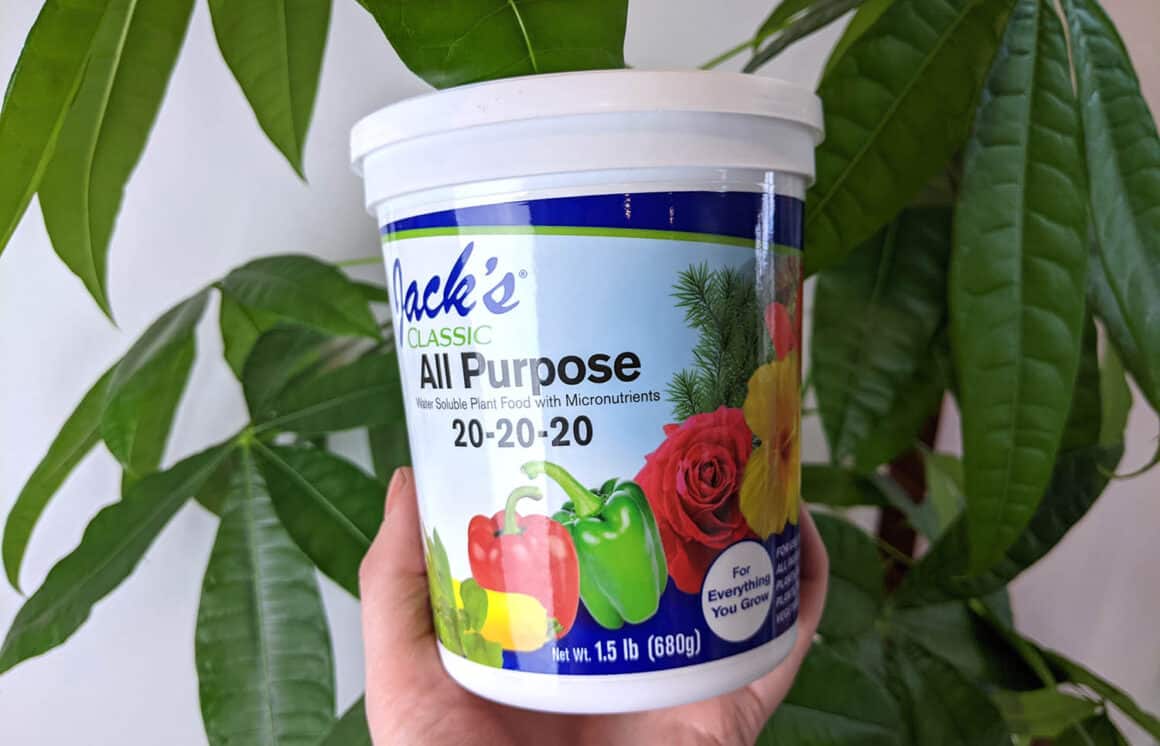
Fertilizer is made up of a combination of natural minerals that, ideally, your plant would have access to in the wild. But once we bring houseplants indoors, we confine them to small pots and halt the additional resources they would naturally absorb through rainwater and access to the earth. Supplementing houseplants with fertilizer is the best method for adding back those naturally occurring minerals to your plant’s ecosystem.
Most store-bought potting soil is fortified with these same fertilizing nutrients, so initially, your Money Tree had all it needed in the soil it was planted in. But after six to twelve months, the nutrients in soil are all absorbed by your plant, and the nutrients are depleted. If your plant has been in the same pot for more than six months, it is most likely in need of a boost of nutrients.
A Quick Word on Growing Season
Before we get into the nitty-gritty of fertilizer, there is something I need you to understand. If your plant has not been growing much lately and you think it could use some fertilizer to boost its health, stop and think about the time of year. Is your Money Tree in its growing season, or is it more likely that the plant is dormant?
Growing season for Money Trees is the time of year where the temperature, daylight, and other environmental factors are ideal for growth. This occurs during the warmest months of the year, and for most of us, falls from spring to early fall. This is the time of year when you will see the most growth from your Money Tree.
But as the days turn cold, plants enter a different phase: dormancy. When plants are dormant, they slow their upward growth to a near standstill as they focus on shoring up their root systems for the cold winter to come. Similar to hibernation, dormancy is a crucial time for plants.
I bring this up because whether or not your Money Tree is in growing season will affect what sort of growth you can expect from the plant, which can then tell you whether or not you should add in any fertilizer. If you aren’t seeing a lot of growth from the plant and believe your Money Tree is in growing season, now is the time for fertilizer. If your plant is dormant, hold off until spring.
Adding in fertilizer to a dormant plant can have adverse effects on its health. Fertilizer can be harsh on a plant that is conserving all of its energy for the upcoming season and can burn or damage root systems in these plants. If you want to fertilize your plant, but it is late fall or winter where you live, now is not the time.
What Fertilizer Is Best For Money Trees?
There are many different house plant fertilizers on the market, and anyone new to fertilizing their houseplants may feel overwhelmed by the sheer volume of options. There is no one “best” fertilizer for houseplants. Most of the options you find online and in stores will work well. But to help you make the best choice, I’m going to go over some questions first and then suggest my favorites.
NPK Ratios – What Are They?
Pick up any bottle of fertilizer and you’ll see a series of numbers on the front formatted X-X-X. These numbers are the NPK ratios and denote how much of each of the three most needed macro ingredients for houseplants are included in the mixture. Let’s break it down so you can see what I mean.
N, P & K stand for nitrogen, Phosphorus, and Potassium, and these numbers tell us what percentage of the fertilizer is made up of each of these ingredients. A fertilizer that is 10-10-10 has 10% nitrogen, 10% phosphorus and 10% potassium, while a 12-6-8 mixture has 12% nitrogen, 6% phosphorus and 8% potassium.
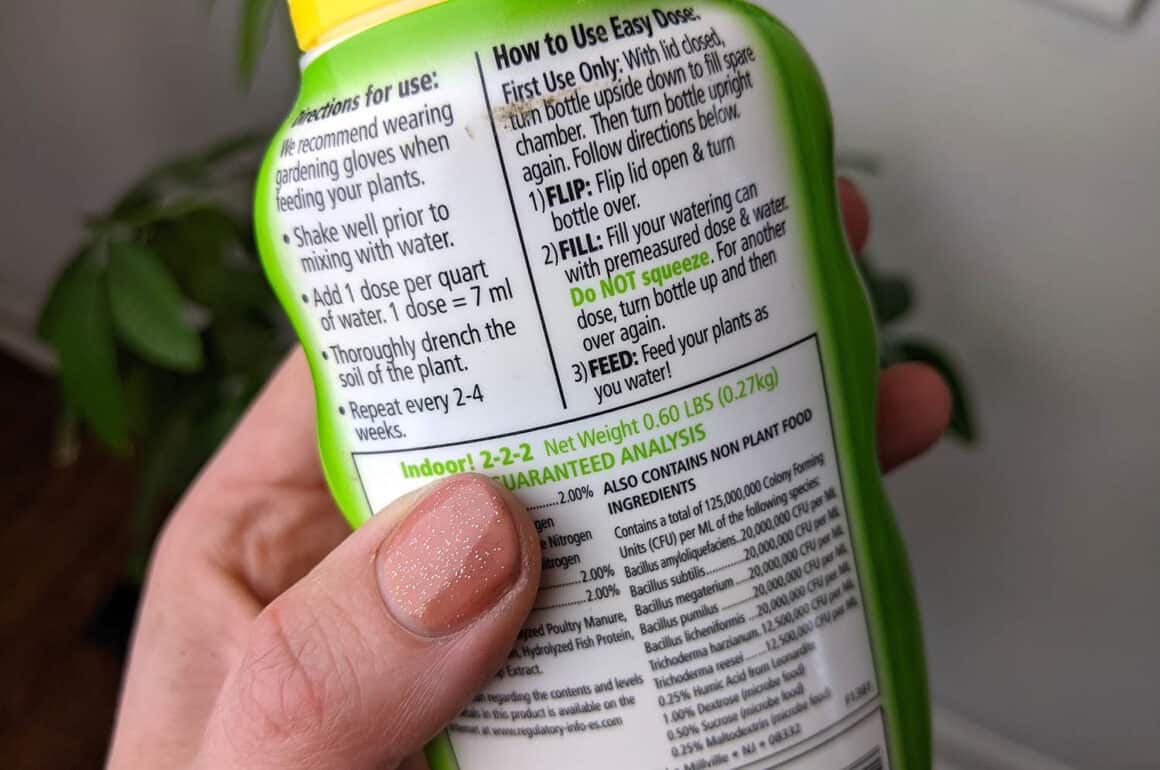
Which fertilizer is best will depend on what type of plant you are trying to supplement. For example, the fertilizer you would use on your front lawn is quite different from that you would use to grow hot peppers. Different types of plants benefit from different levels of nitrogen, Phosphorus, and Potassium. Even different houseplants need different types of fertilizer.
So what does each of these macronutrients do? Nitrogen, the first percentage listed in the NPK ratio, is important for the photosynthesis of plants. It helps to promote leafy, green growth on the plant (think stems and leaves).
Next up, we have Phosphorus, which is extremely important in creating healthy root systems. Phosphorus also encourages flower blooms, so flowering plants often require higher amounts of Phosphorus.
The “K” in NPK stands for Potassium, and it is the macronutrient that helps build up plants to become hardy and tolerate a less-than-ideal environment. Potassium also helps regulate water uptake and improves a plant’s ability to fight off disease.
You’ll see fertilizer formulas with different levels of each nutrient, depending on what it is trying to accomplish. For example, many grass feeds are mainly nitrogen. Commercial “blooming” mixes for annuals and edibles typically punch up the Phosphorus to encourage more flowers.
In the case of a Money Tree, which has a lot of leafy green growth and a root system easily upset by improper watering, we opt for a balanced mix like a 10-10-10 or 20-20-20. We want to make sure all aspects of the plant are benefiting from the feed we provide it.
Which Is Better? Organic vs. Synthetic Fertilizer
After you’ve decided on the NPK balance of your fertilizer, you’ll have to make a choice between organic and synthetic. When we talk about organic in the fertilizer world, this refers to the fact that it has been made with entirely natural ingredients (with no indication of pesticides or other things we think of when we usually think of the word “organic.”) These natural alternatives are generally more expensive than their synthetic counterparts.
Organic fertilizers are better for the earth, but because their components haven’t been processed, they are not ready for immediate uptake by your plant. Instead, organic fertilizers break down in the soil over time and condition your soil to provide the nutrients to your Money Tree in the future.
Synthetic fertilizers are those that are made of natural and chemical components. Because they are chemically formatted and processed, they contain much more precise levels of ingredients. This also allows them to be absorbed by the plant’s roots and sent out to the rest of your Money Tree much more quickly.
When I am fertilizing something that I will eat, like garden veggies or windowsill herbs, I prefer to use organic fertilizers. However, with houseplants like my Money Trees, I almost always use a more exact, cost-effective, synthetic version.
Which is Better? Liquid vs. Granular Fertilizer
The next decision you’ll have to make is whether you want a liquid fertilizer or a granular one. I always choose liquid as I think it is easier to dilute and apply to houseplants, but I’ll explain the difference below.
When I bought my first liquid houseplant fertilizer and received a blue powdered substance in the mail, I thought that the name was a bit deceiving. Though some types are actually liquid, lots of liquid fertilizers are actually powders that you mix with water before applying to your plants.
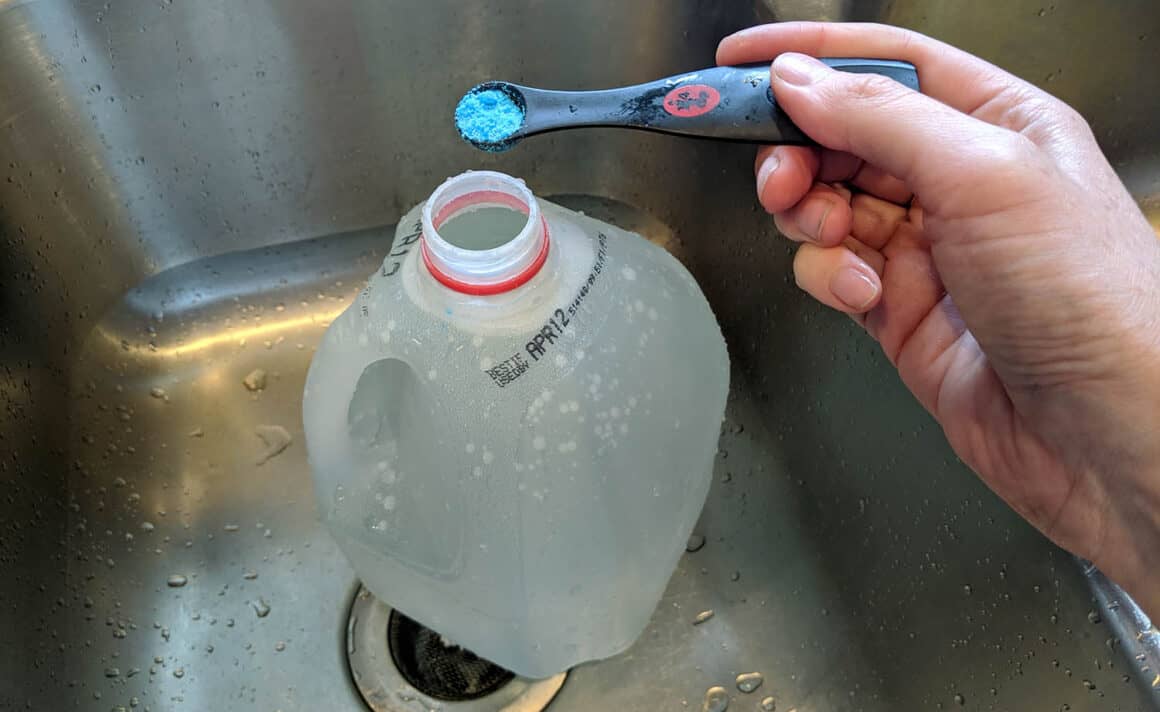
Liquid fertilizer is easy to measure and easy to dilute. And it can be applied to your houseplant in the same way that you generally water. For these reasons, I always choose a liquid option.
Granular fertilizer is made up of pellets that are placed into the soil and slowly release nutrients into the soil over time. Though some people love them, I find them much less precise in application and, therefore, not as good an option for my houseplants, like Money Trees.
My Favorite Houseplant Fertilizers for Money Trees
Whenever people ask me what fertilizer to use on their houseplants, I have two recommendations I always make: Jacks All Purpose 20-20-20 Houseplant Fertilizer and Espoma Organic 2-2-2 fertilizer. Both options are balanced in their N-P-K ratios, but Jacks is a powder and synthetic, while Espoma is liquid and organic.
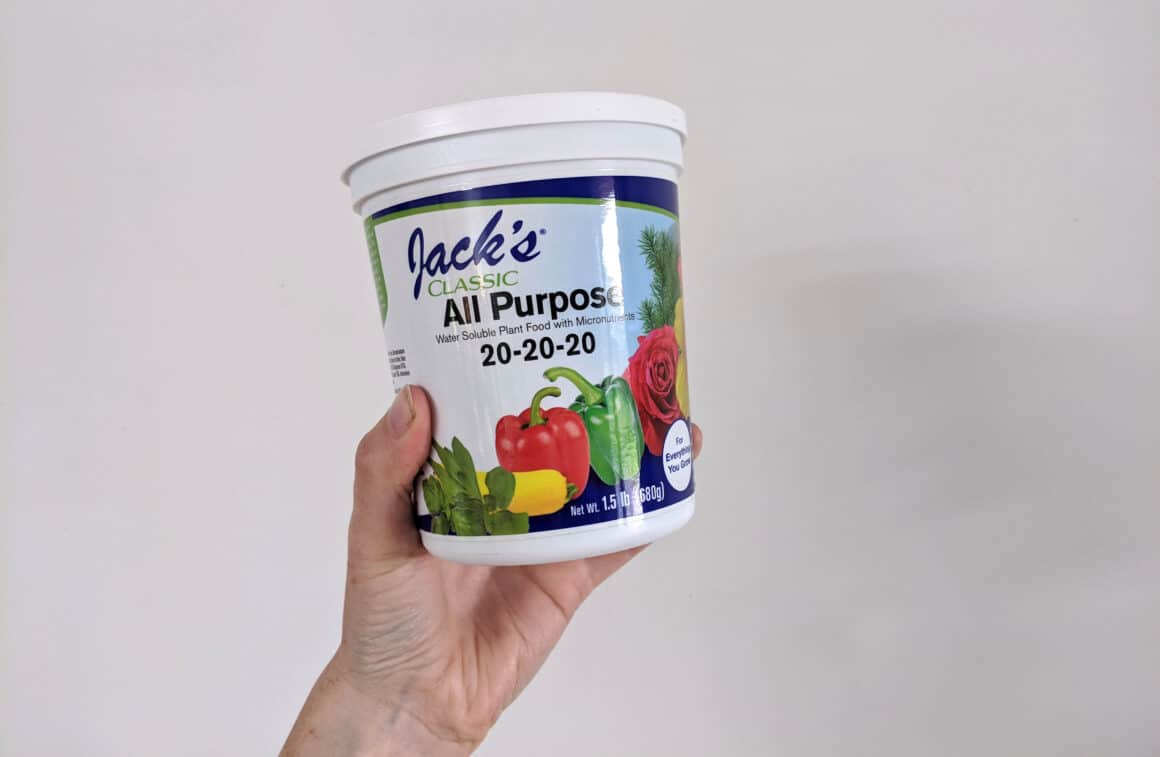
Jack’s is my favorite and is my go-to fertilizer for my Money Trees. The price is very reasonable, and because I use less than a teaspoon at a time, it lasts for a really long time. I always recommend diluting fertilizer to half strength, but because Jack’s is a 20-20-20 mixture (instead of 10-10-10) so I usually dilute it to quarter strength – making it last even longer.
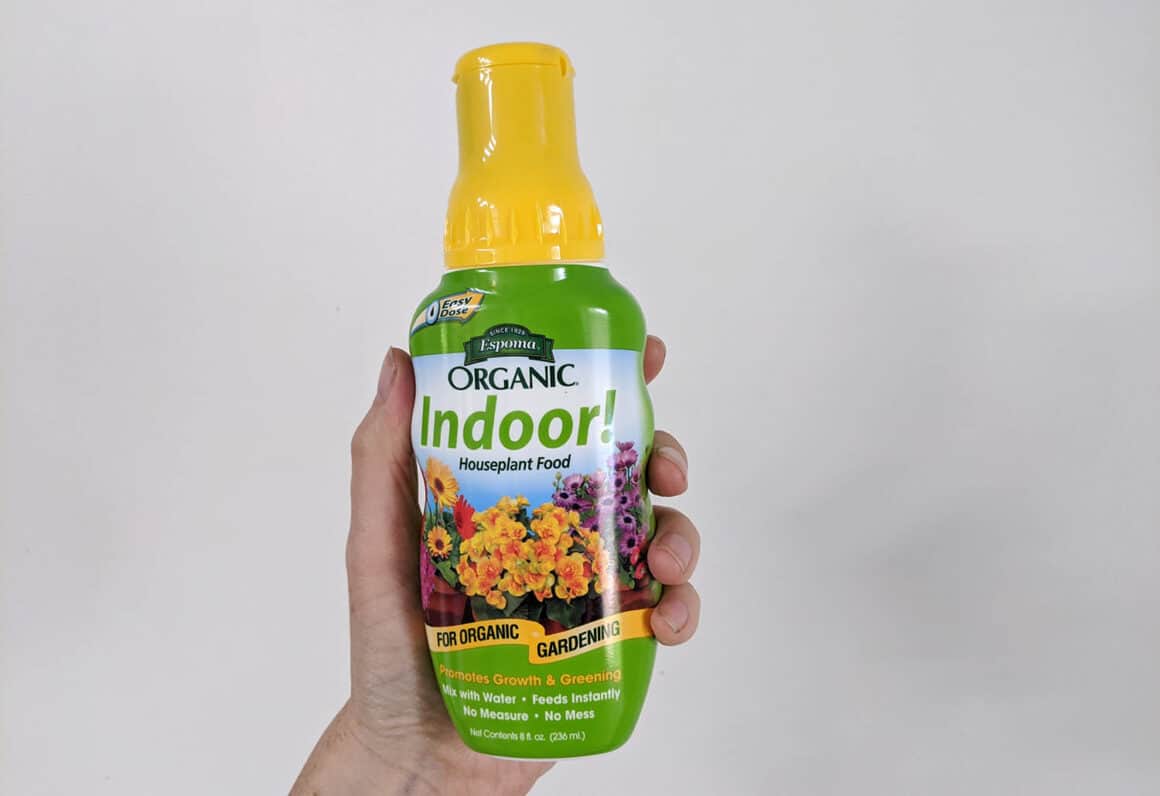
If you prefer an organic option, Espoma is an excellent choice. The price is reasonable (though more expensive than Jack’s), and it does very well with houseplants. Both options are easy to find online and either would be excellent for a Money Tree.
How Often to Fertilize Money Trees
As a good rule of thumb, you should fertilize most houseplants, Money Trees included, about once per month during the growing season. Some people suggest fertilizing every two weeks, but I prefer the monthly schedule. Too much fertilizer can damage plants and burn roots and leaves. For that reason, I like to go easy and keep my timing to once per month.
But remember what I said earlier about growing season vs. dormancy? You only want to fertilize your plant when it has the energy it needs to process the nutrients and send them out to the rest of the plant. If your Money Tree is dormant (a.k.a. It is cold outside), hold off until spring.
Always Dilute Fertilizer to Half Strength
I cannot say this loud enough: Always, always, always dilute your fertilizer. Mixtures that are too harsh will burn your plant’s root system and damage them so they cannot uptake water and nutrients and send them out to the rest of the plant. Too much fertilizer is a very bad thing.
Even if you follow the directions to a T, some mixtures will be too strong for your houseplants. If the instructions call for 1 tsp of fertilizer to 1 gallon of water, I use 1/2tsp to one gallon of water. I would always rather play it safe and dilute the mixture to at least half strength. Remember, you can always add more, but it is difficult to take it back once you’ve poured fertilizer onto your beloved plant.
The first sign a plant has been burned by fertilizer is usually seen in the tips of the leaves. Yellow or brown tipped leaves are often an indicator that the plant isn’t getting enough water and, if you’ve recently fertilized your plant, that may be a result of burned roots.
Roots damaged by too much fertilizer cannot efficiently uptake water and nutrients, and therefore, the plant suffers. Other signs are brown and yellow leaves or a fertilizer crust on top of the soil. If you see any of these signs, you may have been heavy-handed with your fertilizing.
How to Remedy Fertilizer Burn
If you’ve seen yellow or brown tipped leaves or a crunchy crust develop on top of your soil, you have probably given your plant too much fertilizer. So what can be done? Is your plant doomed?
Usually, if you catch it early enough, you can help to flush the remaining fertilizer from the soil before it damages your plant any further. Take your plant to the shower or sink and let the water run through the soil and out the drainage hole in the container’s bottom for three to five minutes. This will flush the excess fertilizer from the soil and should stop the damage.
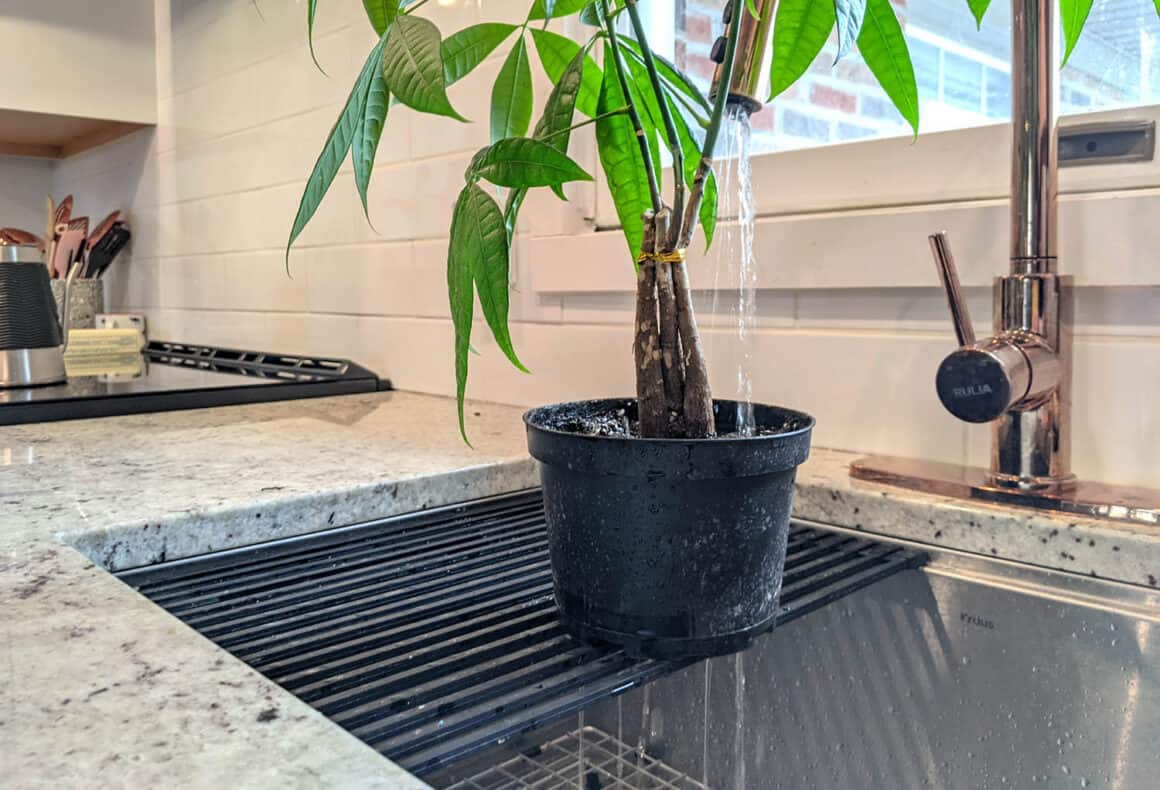
Unfortunately, what has been done is done. The tips of your leaves will not turn back to green, but flushing the soil should stop further damage. This is why it is essential to only fertilize during growing season when your plant has the energy it needs to recover from stress and damage. Better safe than sorry.
Refreshing Soil Instead of Adding Fertilizer
If the idea of fertilizing your plant still doesn’t sit well with you, your other option is to refresh the potting soil in your Money Tree’s container. Store-bought potting soil is fortified with slow-release nutrients and provides your houseplant with what it needs – that is, until those nutrients have been depleted.
If your Money Tree has been in the same container for more than six months, you could use a spoon or shovel to gently remove the top layer of soil and replace it with fresh. Once you water your plant, the nutrients will be released, and your Money Tree will get a small boost from the new potting soil.
When Is It Time To Replant?
Fertilizer alone will not keep a Money Tree growing forever. At a certain point (usually once every two years), you’ll need to up the size of the container your plant is growing in to give it room to keep expanding.
If your Money Tree has become rootbound, you’ll need to move it to the next larger size of pot. Roots that are growing out of drainage holes, and soil that lets water run through too quickly without absorbing any, are both signs that plants are root-bound. If neither of those is occurring, but you still suspect your Money Tree to be rootbound, remove it from its container and take a look at the roots.
If a plant’s roots are coiled up and spiraling in on themselves, it is time to transplant your Money Tree. For more information on replanting Money Trees, see this article with step by step instructions.
Putting It All Together
I’m hoping that if your head was spinning before at the thought of fertilizing your houseplants, that you’re feeling much better now. Most store-bought fertilizers that are formulated for houseplants will be good choices for your Money Tree, but you can decide whether you prefer the thoughts of organic or synthetic and more.
No matter which option you choose, remember to dilute your fertilizer to half strength before applying it to your Money Tree. Too much fertilizer is dangerous for plants. Remember: You can always add more fertilizer later; it is much more difficult to remove excess.






